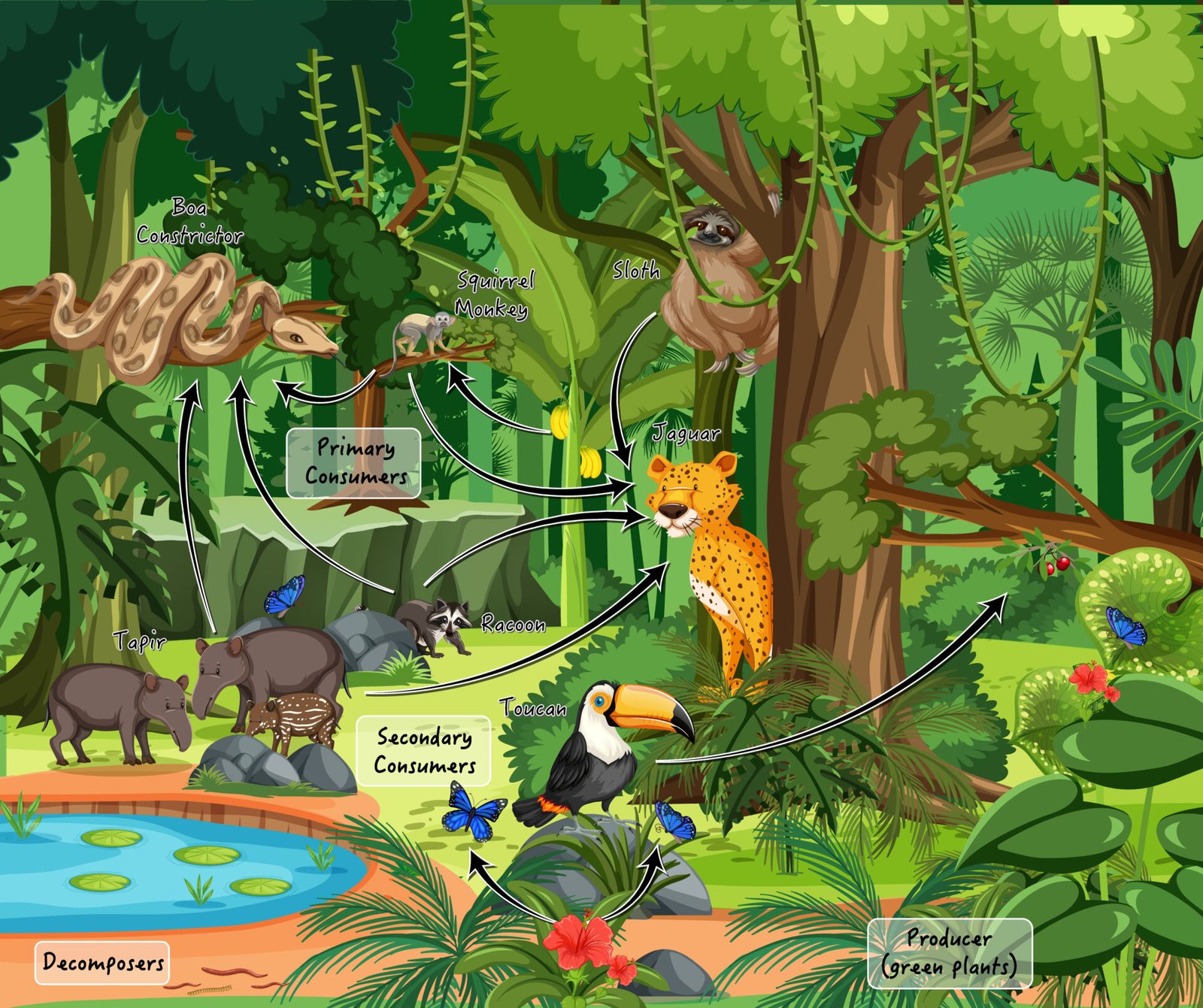Have you ever wondered how the world’s most diverse ecosystem sustains itself? The answer lies in the rainforest food web – a delicate balance of predators, prey, and the invisible forces that bind them. Every tree felled, every species lost, disrupts the intricate connections that keep this vibrant ecosystem alive.
⫸ Introduction to Rainforest Ecosystems
Rainforests are nature’s powerhouses, teeming with more diverse and abundant life than anywhere else on Earth. Let’s delve into the features that make them so unique:
Defining rainforests: Lush biodiversity hotspots
- Rainforests are characterized by high rainfall and year-round warmth, creating the perfect conditions for plant and animal life explosion.
- They cover less than 6% of Earth’s land surface but are home to over half of the world’s known plant and animal species.
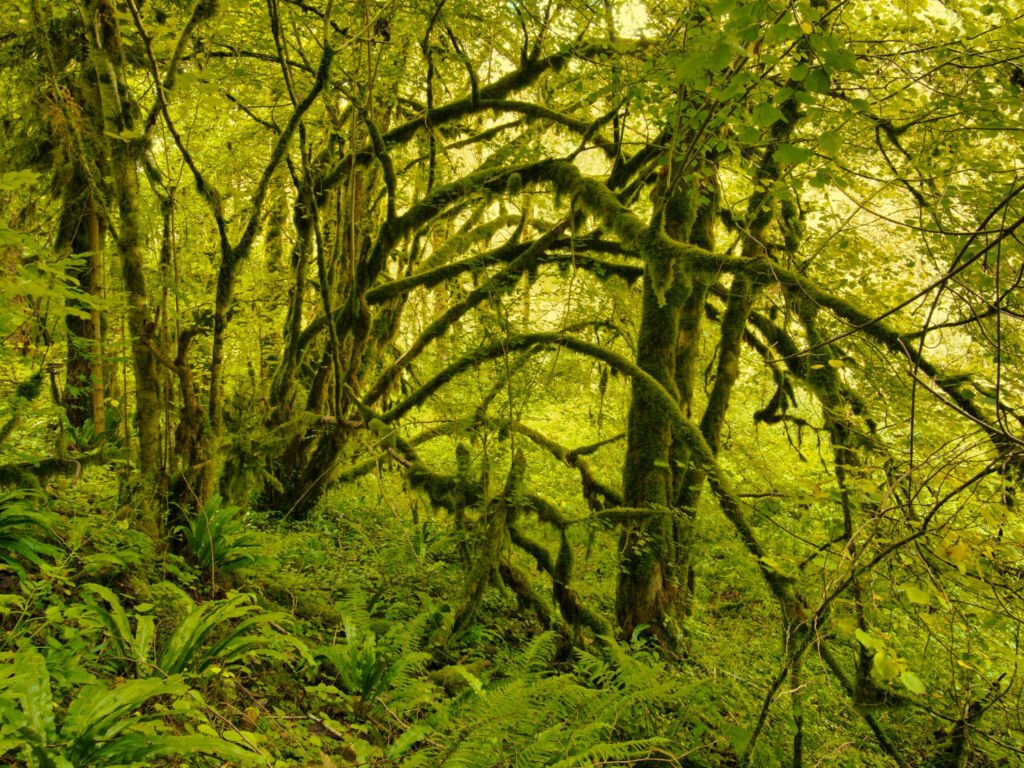
Biodiversity and abundance of life within rainforests
- Rainforest biodiversity is mind-boggling: A single acre can contain hundreds of tree species, thousands of insects, and countless other organisms.
- Life exists in layers – from the dark forest floor, teeming with decomposers, to the sun-drenched canopy where monkeys swing, and colorful birds soar.
- Many rainforest species have yet to be discovered, and they hold potential cures for diseases or revolutionary new technologies.
Food webs vs. food chains: Understanding the difference
- A food chain is a simple linear path of who eats whom (e.g., leaf -> caterpillar -> bird -> snake).
- The rainforest food web is far more complex. It’s an interconnected network where one organism might prey on several predators and have multiple food sources.
- This complexity makes the rainforest ecosystem more resilient to change and vulnerable to disruption.
⫸ Layers of the Rainforest
Rainforests aren’t just a tangle of green; they’re structured ecosystems with distinct layers. Each layer boasts a unique set of plants, animals, and challenges crucial to the rainforest food web. Let’s journey through the rainforest’s vertical world:
Emergent layer: The giants
- Towering above all else, trees in the emergent layer can reach over 200 feet tall.
- These giants are exposed to blazing sun and strong winds and have small, tough leaves to reduce water loss.
- The emergent layer, home to eagles, monkeys, and even bats, offers panoramic views for hunting and finding food sources.
Canopy layer: Hub of activity
- The dense canopy forms a leafy roof over the rest of the rainforest.
- Most rainforest life thrives here – a bustling mix of insects, birds, snakes, and primates.
- Abundant flowers, fruits, and leaves provide a rich food source, fueling the rainforest food web.
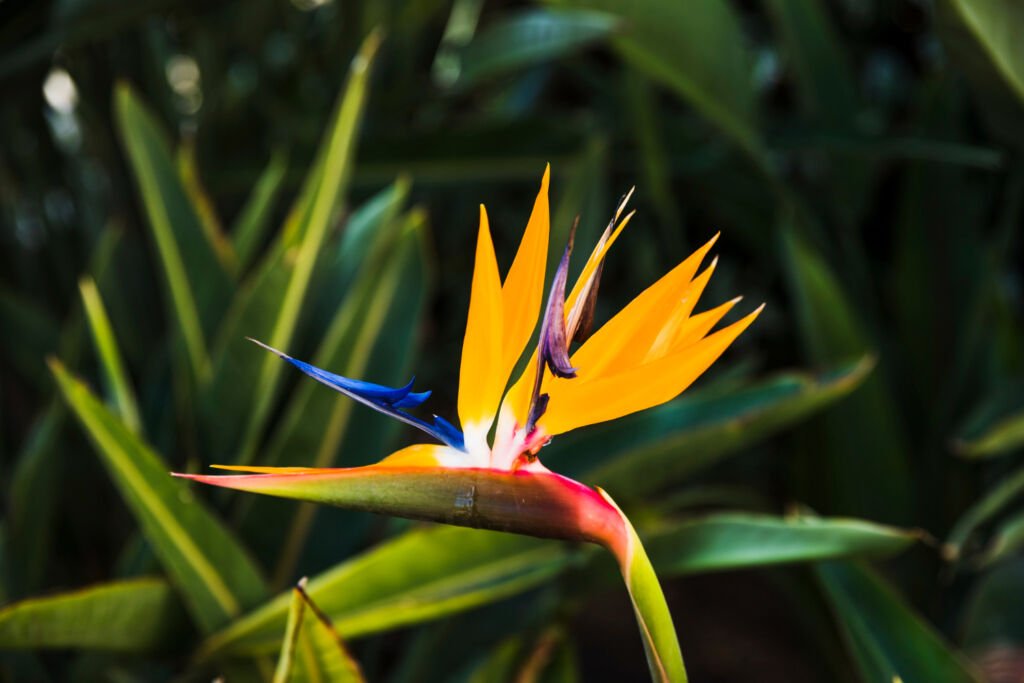
Understory: Sunlight Seekers
- In the dim understory, plants compete fiercely for the limited sunlight filtering through the canopy.
- Large leaves and clever adaptations, like climbing vines, help plants maximize light capture.
- Jaguars, insects, and colorful frogs are some creatures inhabiting this shady layer.
Forest floor: The recycling zone
- Here, sunlight is scarce; the forest floor is a realm of decaying leaves and fallen fruits.
- Fungi, insects, and other decomposers thrive here, breaking down organic matter and releasing nutrients into the rainforest soil.
- This vital process replenishes the rainforest food web from the bottom up, ensuring nutrients are available for future generations of plants and animals.
⫸ Producers: The Foundation of the Rainforest Ecosystem
Rainforest ecosystems would only exist with the tireless work of producers. These remarkable organisms form the base of the rainforest food web, harnessing the sun’s energy to create the fuel that powers this dazzling world of life.
Photosynthesis and Primary Production
- Producers convert sunlight, carbon dioxide, and water into sugars (food) and oxygen through photosynthesis.
- This stored energy becomes available to the following levels of the rainforest food web as consumers eat the producers.
- Rainforests are powerhouses of primary production, meaning they generate a massive amount of new organic matter.
Key Types of Rainforest Producers
- Trees come in all shapes and sizes, from towering giants to understory saplings.
- Canopy trees Form the dense overhead foliage, soaking up most of the sunlight.
- Understory trees: Adapted for lower light levels.
- Emergent trees: Break through the canopy, reaching incredible heights.
- Epiphytes: Plants that grow on other plants for support (orchids, bromeliads) get light and nutrients without needing soil.
- Vines: Climb or creep on trees, using them to reach toward sunlight.
- Algae and phytoplankton: Microscopic producers form the base of aquatic food chains within the rainforest.
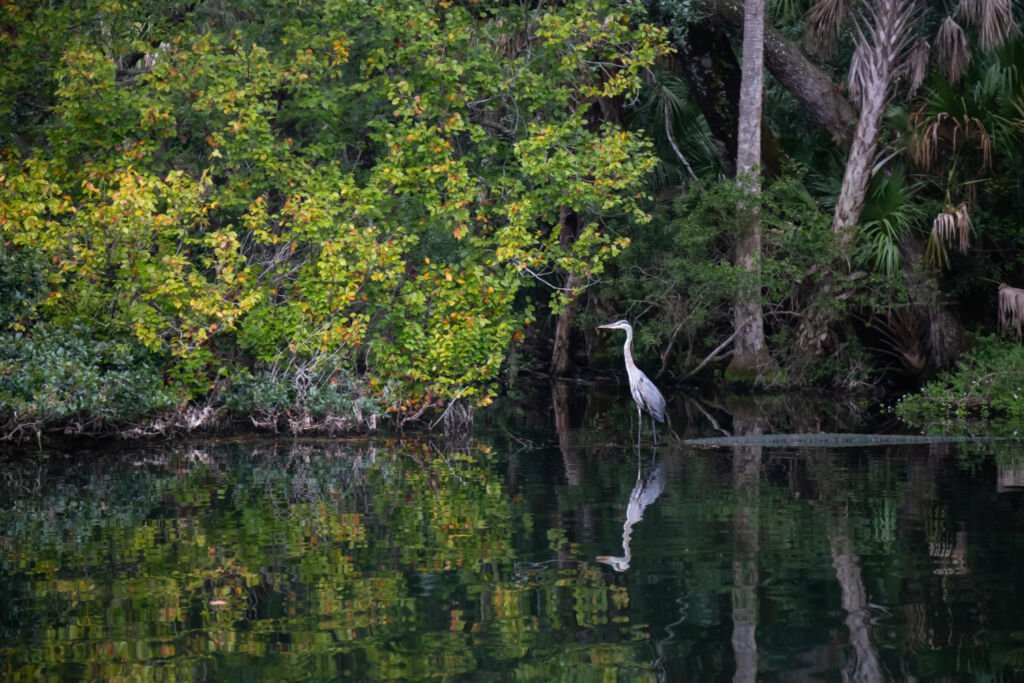
Adaptations for Sunlight Competition
- Rainforest plants compete fiercely for light! Here’s how they adapt:
- Tallness: Emergent trees stand above the canopy for maximum sunlight.
- Broad leaves: Capture as much light as possible.
- Fast growth: Vines race to sunlight by climbing existing structures.
⫸ Primary Consumers: The Herbivores of the Rainforest
Rainforest herbivores, the primary consumers, are the vital link between the plant world and the rainforest food web’s higher levels. These creatures have evolved remarkable ways to thrive on the rainforest’s plant-based bounty, developing specialized diets, clever camouflage, and unique survival strategies in a world full of hungry predators.
Diverse rainforest herbivore adaptations
- Specialized diets (leaves, fruits, nectar): Rainforest herbivores specialize in different plant parts:
- Leafeaters: Animals like sloths and leafcutter ants deal with tough, fibrous leaves with limited nutrition.
- Frugivores (Fruit-eaters): Toucans and monkeys enjoy the sugary rewards of fruits and play a vital role in seed dispersal.
- Nectarivores: Hummingbirds and certain bats extract high-energy nectar from flowers, often aiding pollination.
- Camouflage and defense mechanisms
- Blending in: Many insects, like stick bugs, mimic their surroundings to become nearly invisible to predators.
- Startling colors: Some brightly colored butterflies and frogs advertise their toxicity, warning predators of unpleasant consequences.
- Protective groups: Herds of zebras or flocks of birds can confuse predators, making it harder to target individuals.
- Heightened senses: Many herbivores have exceptional senses of smell or hearing to locate the best food sources or detect approaching danger.
- Speed and agility: Some herbivores rely on sheer speed or acrobatic skills to escape predators.
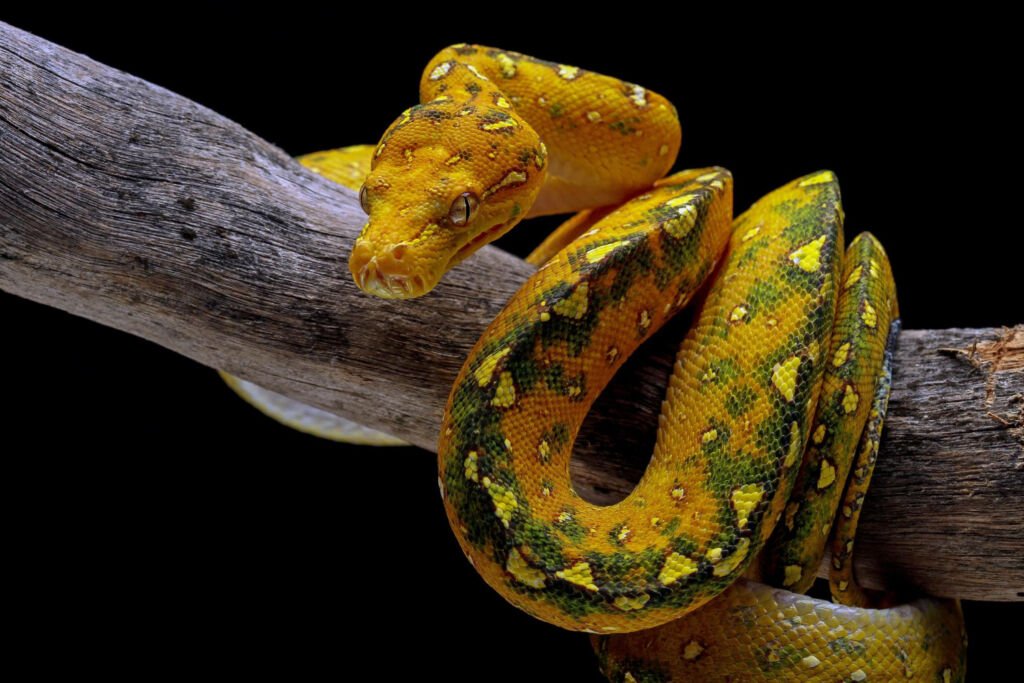
Examples of rainforest herbivores
Insects (leafcutter ants, beetles, butterflies)
- Leafcutter ants form vast colonies, harvesting leaves to feed their underground fungus gardens.
- Beetles come in various shapes and sizes, with specialized mouthparts to feed on different plant resources.
- Butterflies sip nectar and contribute to pollination with their delicate wings.
Mammals (sloths, monkeys, tapirs)
- With their slow metabolism, sloths consume nutrient-poor leaves and spend most of their lives upside-down.
- Monkeys use their agility to reach fruits and seeds high in the canopy.
- Tapirs, resembling pig-like creatures, browse on leaves, fruits, and tender shoots.
Birds (toucans, parrots)
- With their oversized beaks, Toucans pluck fruits and disperse seeds throughout the rainforest.
- Parrots use their strong beaks to crack open tough nuts and seeds.
Strategies for finding food and avoiding predators
- Height advantage: Many herbivores browse at different heights in the rainforest, reducing resource competition.
- Group living: Flocking or herding behavior provides safety in numbers.
- Nocturnal activity: Some herbivores forage under darkness to avoid daytime predators.
⫸ Secondary and Tertiary Consumers: Rainforest Predators
Predators hold a vital place within the rainforest food web, shaping the populations of other species and keeping the intricate ecosystem in balance. Let’s dive into their world:
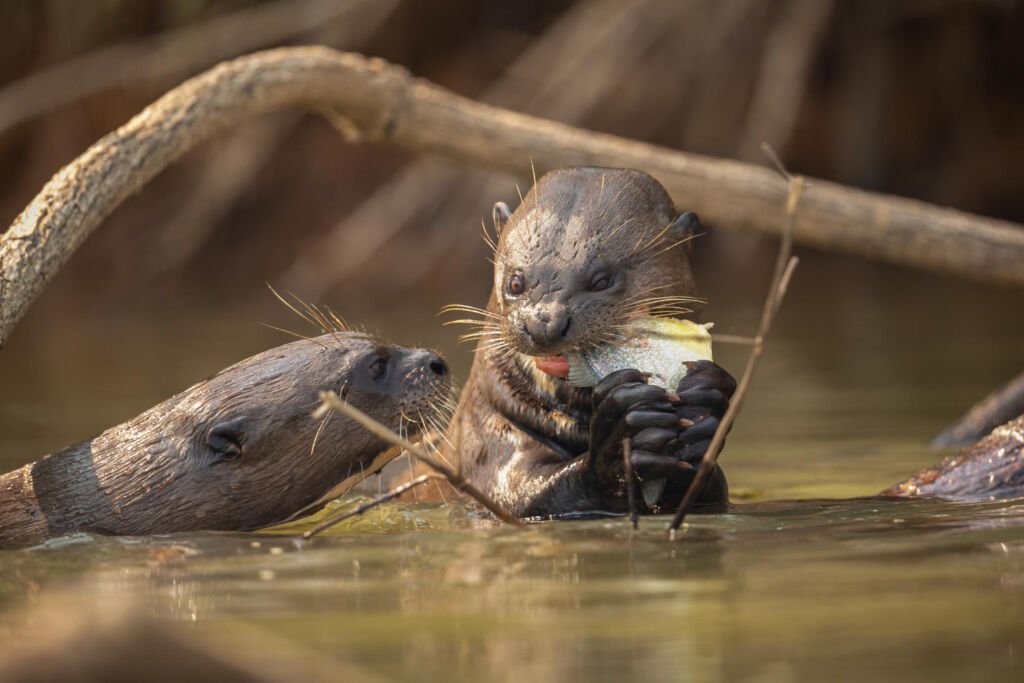
The Role of Predators in the Food Web
- Population Control: Predators keep prey populations in check, preventing overgrazing and resource depletion.
- Ecosystem Health: Predators help maintain healthy prey populations by targeting weaker individuals.
- Nutrient Cycling: Predator waste and leftover kills contribute to the rainforest’s nutrient-rich soil.
- Shaping Evolution: The constant pressure of predation drives evolutionary changes in predators and prey.
- Natural Selection: By targeting weaker or slower prey, predators help ensure the healthiest animals reproduce, passing on strong genes.
Types of Rainforest Predators
- Mammals: Jaguars, ocelots, pumas – powerful cats with specialized senses for hunting in the dense forest.
- Birds: Eagles like the Harpy Eagle boast incredible eyesight and talons to pluck prey from the canopy.
- Reptiles: Snakes like the anaconda use ambush tactics, while caimans hunt in waterways.
- Invertebrates: Spiders are surprisingly skilled rainforest hunters with venomous bites and elaborate webs.
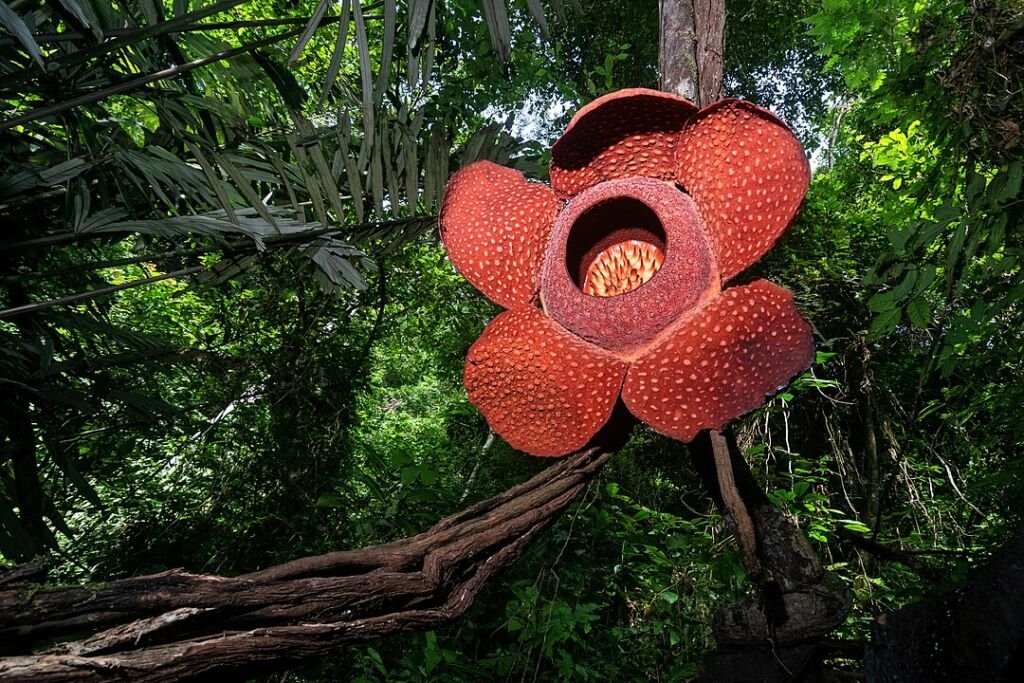
Ambush Predators (snakes, jaguars)
- Camouflage and stealth are key for ambush hunters. They allow them to blend with their surroundings and surprise their prey.
- Some snakes possess heat-sensing organs to detect warm-blooded prey even in darkness.
- Jaguars use their spotted coats to blend into the dappled light, launching powerful surprise attacks.
Active Hunters (eagles, spiders)
- Eagles rely on keen eyesight and speed to swoop on prey from above.
- Though small, spiders are masters of deception and patience. Some spin intricate webs, while others actively chase down insects.
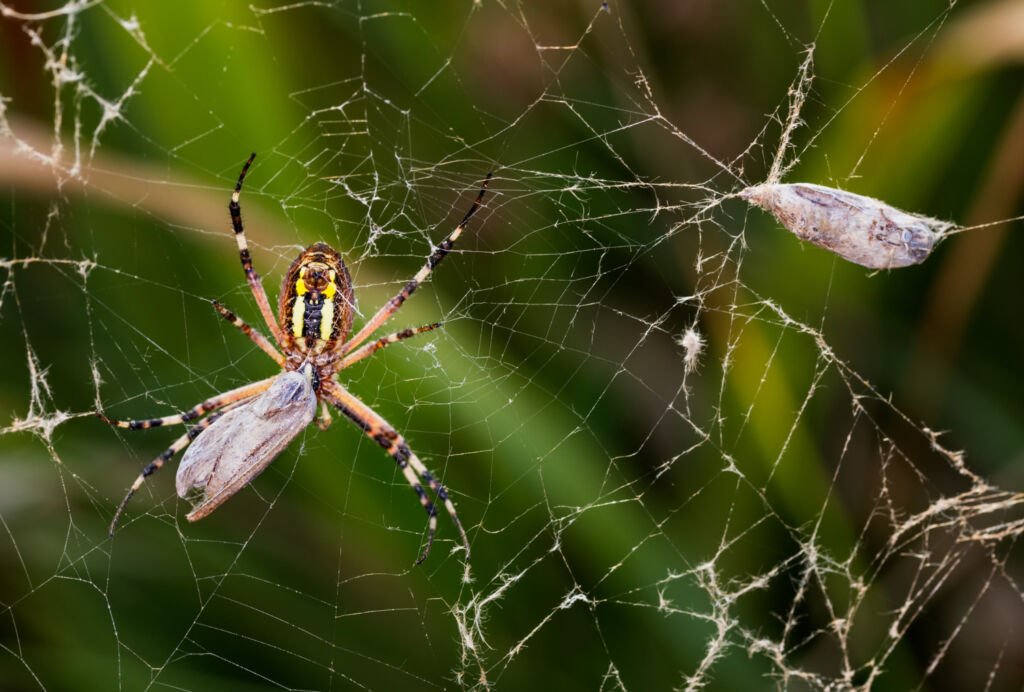
Predator-Prey Relationships and Adaptations
The rainforest is an arena of constant evolutionary adaptation:
- Prey develops defenses: Monkeys use speed and agility, insects use camouflage, and some plants develop toxins.
- Predators counter-adapt: Jaguars develop stealth, snakes evolve potent venom, and spiders refine their ambush tactics.
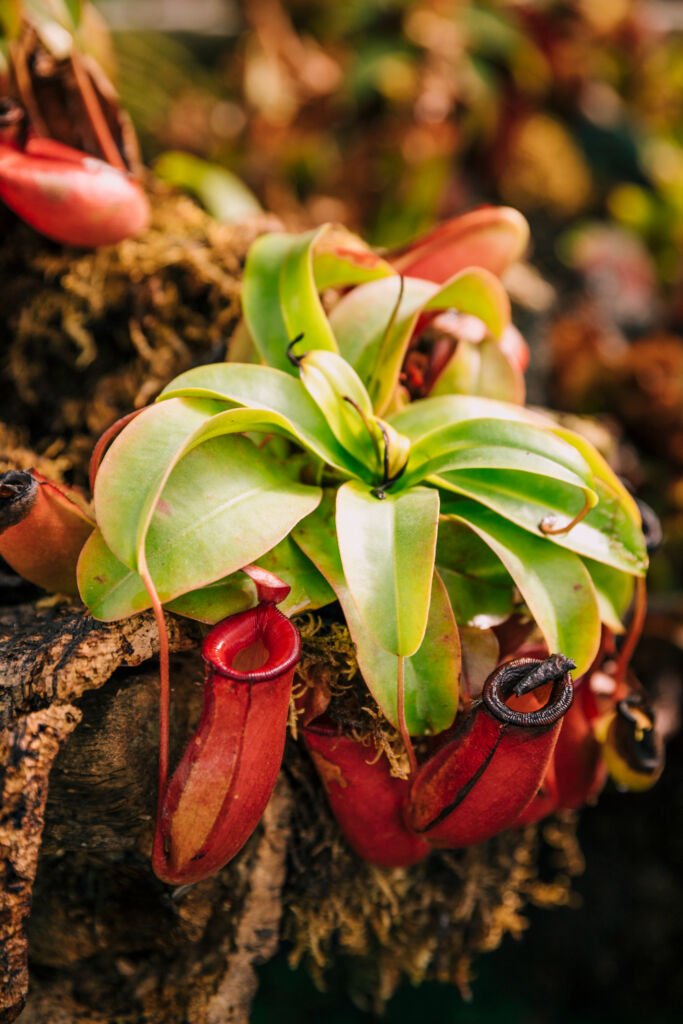
Remember: Predators are essential to the rainforest food web, ensuring a healthy, dynamic ecosystem.
⫸ Omnivores: The Adaptable Eaters of the Rainforest
Omnivores occupy a unique niche in the rainforest food web. These versatile creatures are key to survival in the lush but often unpredictable rainforest environment. With the ability to consume both plants and animals, they boast flexible diets and resourceful strategies.
Animals that eat both plants and animals
- Primates: Many monkeys, like Capuchins and spider monkeys, rely heavily on fruits but opportunistically supplement their diets with insects, bird eggs, or even small lizards.
- Coatis: These raccoon relatives use their long snouts to sniff out insects, grubs, fruits, and sometimes eggs or small animals.
- Toucans: Their iconic beaks are perfect for plucking fruits, but they’ll also snatch insects, lizards, or even the eggs of other birds.
- Wild Pigs: Peccaries are known to root through the rainforest floor, consuming grubs and insects, but also enjoy fruits, seeds, and roots when available.
Examples and their flexible diets
- Agoutis: These squirrel-like rodents eat fallen fruits and nuts but will hoard them for leaner times. They also opportunistically consume insects for protein.
- Peccaries: These wild pig relatives root around for fruits, tubers, and mushrooms but willn’t turn down insects or even small carrion when they find them.
⫸ Decomposers: Recycling Nutrients in the Rainforest
The rainforest floor might seem like a graveyard of fallen leaves and decaying matter, but it’s a hotbed of hidden activity. Here, nature’s undertakers, the decomposers, work tirelessly to break down waste and transform it back into life-giving nutrients.
Breaking down dead matter
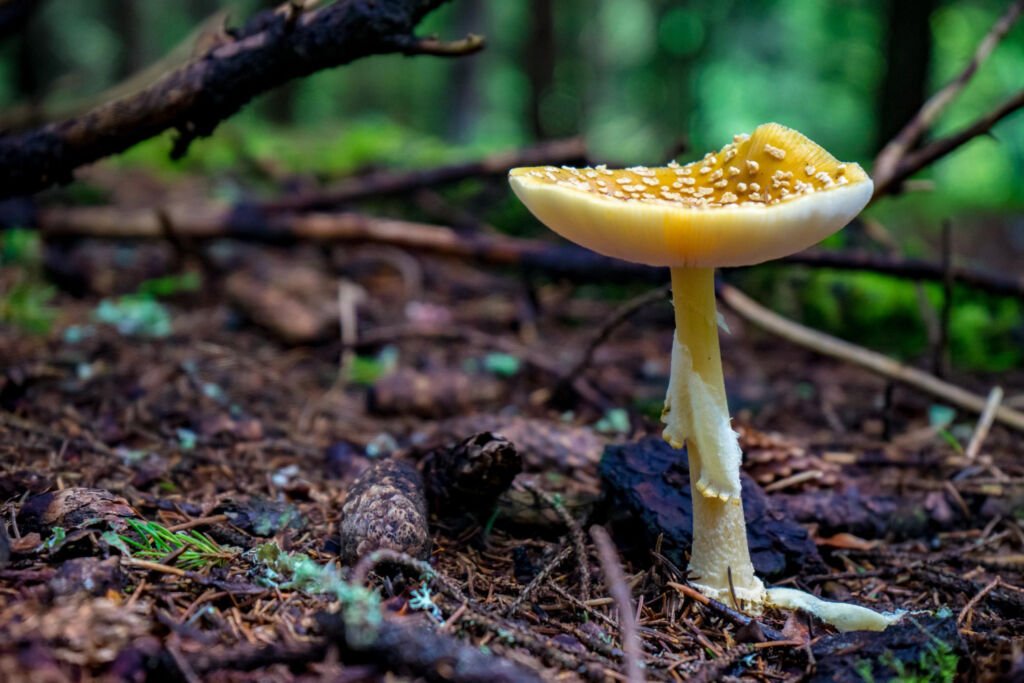
- Fungi are masters of decomposition. Their networks of hyphae (thread-like filaments) penetrate dead matter, releasing enzymes to break down tough materials like wood.
- Bacteria: Microscopic powerhouses rapidly digest softer organic matter and release vital compounds like nitrogen and phosphorus into the environment.
- Insects: Millipedes, termites, and beetles act like tiny shredders, consuming dead plant matter and creating easier access for fungi and bacteria.
Returning nutrients to the rainforest soil
- As materials decompose, nutrients like nitrogen, phosphorus, and potassium become available in the soil.
- Rainforest trees have shallow roots, quickly absorbing these nutrients to support their rapid growth.
- Soil enriched by decomposers supports a rich undergrowth of seedlings and diverse plant life.
How decomposers close the nutrient loop
- Decomposers are the final link in the rainforest food web. They keep nutrients flowing from dead organisms back into the living ecosystem.
- Without them, dead matter would pile up, nutrients would be locked away, and the rainforest would slowly starve itself.
- Decomposers ensure the constant renewal and regeneration that makes the rainforest such a vibrant and productive place.
⫸ Energy Flow and Trophic Levels
The rainforest food web isn’t just about who eats who—it’s a story of energy. Sunlight fuels the rainforest, and as this energy journeys through the ecosystem, it shapes the relationships between all living things. Let’s dive into how this works:
Explaining food chains and food webs
- Food chains are simple, linear paths of energy transfer. Consider how a leaf is eaten by a caterpillar, which in turn is eaten by a bird.
- Food webs: Rainforests need to operate in neat lines. Food webs show the complex network of interconnected food chains, offering a more realistic picture of energy flow.
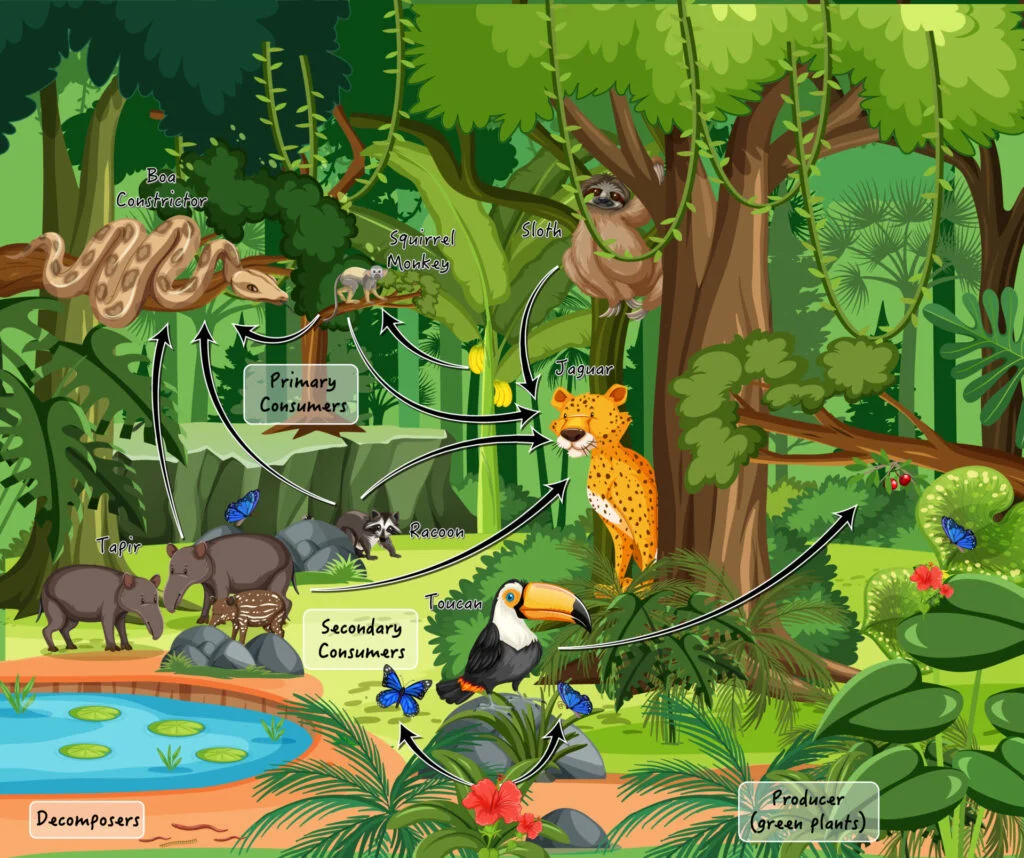
Trophic levels (producers, primary consumers, etc.)
- Producers: Plants! They harness sunlight, making their food through photosynthesis.
- Primary Consumers: Herbivores munch on the producers – insects, monkeys, and sloths.
- Secondary Consumers: Carnivores and omnivores eat the primary consumers (snakes, jaguars, and some birds).
- Tertiary Consumers & Beyond: Apex predators at the top of the chain.
- Decomposers: The cleanup crew! Fungi, bacteria, and insects recycle nutrients back into the system.
Lindeman 10% Law: The 10% energy transfer rule
- Only about 10% of energy is passed to the next trophic level when one organism eats another.
- The rest is used for life processes (movement, digestion) or lost as heat.
- This is why rainforests need so many producers to support fewer top-level predators.
⫸ Keystone Species: Architects of the Rainforest
Keystone species are the master builders of the ecosystem. They might not be the most numerous or noticeable, but remove them, and the structure risks collapse. Let’s dive into their vital role within the rainforest food web.
Crucial organisms that shape the entire ecosystem
- Population Control: Keystone species often keep prey populations in check, preventing overgrazing or imbalances that could damage the entire ecosystem.
- Food Source: Many keystone species are the primary food for numerous other animals, ensuring the survival of others along the food web.
- Habitat Engineers: Certain species, like beavers, physically change the environment, creating habitats other creatures depend on. In rainforests, fig trees offer fruit and shelter, becoming mini-ecosystems themselves.
- Seed Dispersal: Animals that eat fruits and disperse seeds (like toucans and monkeys) are crucial for rainforest plant reproduction and maintaining diversity.
Examples in the rainforest food web
- Jaguars: As apex predators, they control populations of herbivores, preventing overgrazing that could destroy the rainforest understory.
- Fig Trees: These giants provide fruit year-round, sustaining countless birds, bats, monkeys, and insects.
- Bees: Vital pollinators, ensuring the reproduction of flowering plants, the foundation of the food web.
- Agoutis: Known as “gardeners of the forest,” they bury large seeds, contributing to the growth of future rainforest trees.
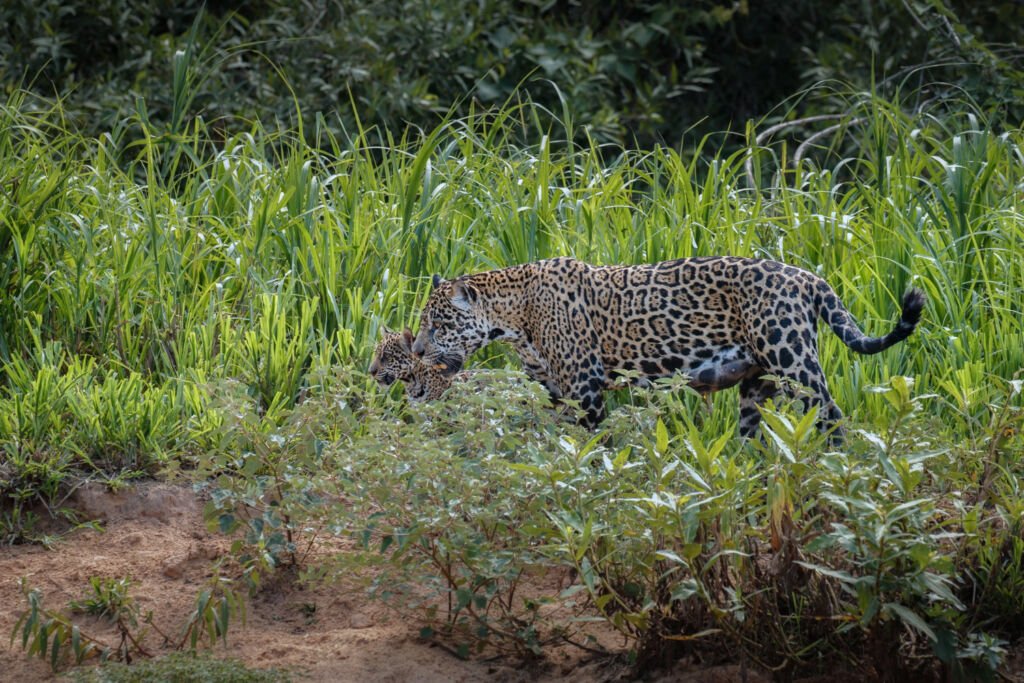
⫸ Threats to the Rainforest Food Web
The intricate connections within the rainforest food web are remarkably resilient, yet they face many threats, primarily driven by human actions. Let’s dive into the most pressing dangers:
Deforestation and its impact
- Large-scale clearing of rainforests for agriculture, logging, and development destroys the foundation of the food web.
- Primary producers vanish, depriving herbivores of their food source, with effects cascading up the chain.
- The loss of trees reduces shelter and breeding grounds for countless species.
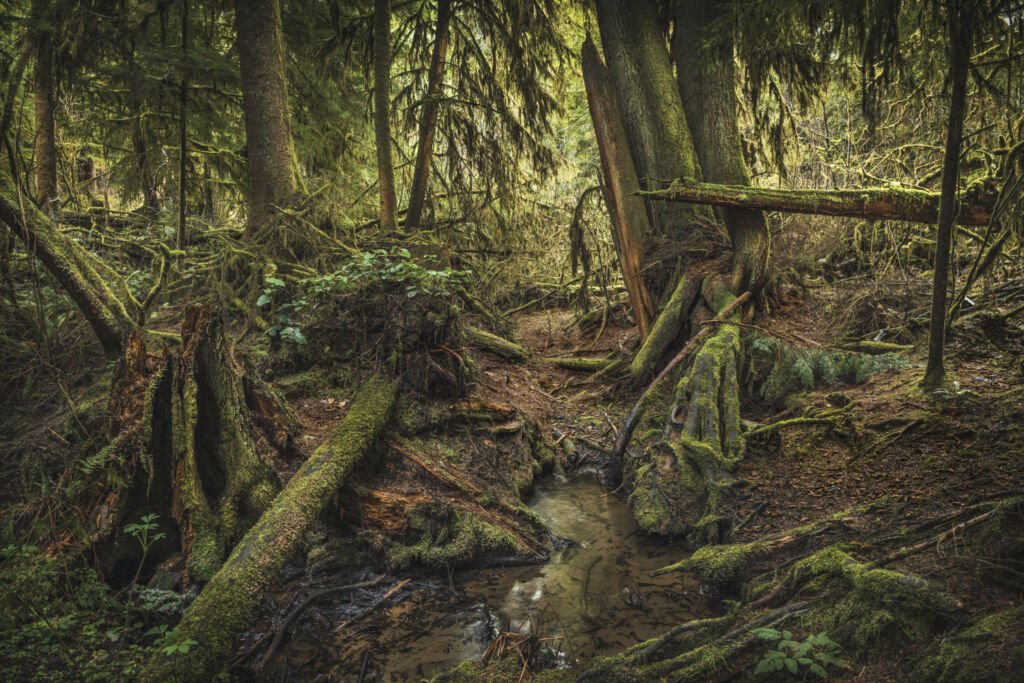
Habitat fragmentation and loss
- Deforestation often leaves patches of isolated forest. This disrupts migration routes and gene flow, weakening populations.
- Smaller habitats support fewer species and disrupt predator-prey relationships.
- Edge effects expose species to harsher conditions and increased vulnerability.
Invasive species
- Non-native plants and animals introduced to rainforests can outcompete native species for resources.
- Invasive predators, lacking natural enemies themselves, can decimate prey populations.
- New diseases carried by invasive species can spread through vulnerable populations.
Climate change effects
- Rising temperatures and altered rainfall patterns stress rainforest plants and animals adapted to specific conditions.
- Droughts and floods disrupt food availability and breeding cycles.
- Species unable to migrate or adapt may face extinction, leaving gaps in the food web.
The cascading effects of disruptions
- The loss of even one species can have far-reaching consequences within the rainforest food web.
- Reduced populations of pollinators impact plant reproduction.
- Disappearance of predators can lead to overpopulation of prey species straining resources.
- The breakdown of these connections weakens the entire ecosystem, making it less resilient to other threats.
Remember, these threats don’t operate in isolation. They compound each other, accelerating the decline of this vital ecosystem and the intricate web of life it supports.
⫸ Conservation Efforts: Safeguarding the Rainforest's Lifeline
The intricate rainforest food web is a testament to nature’s balance, but this vital system is threatened. Conservation efforts are paramount to ensure the survival of the rainforest’s astonishing biodiversity. Here’s how we can make a difference:
The Importance of Conservation
- Rainforest food webs are essential for maintaining global biodiversity and ecological balance.
- Disruptions to the food web can lead to species extinctions and cascading negative effects.
- Healthy rainforests regulate climate, provide clean water, and offer potential resources for medicine and scientific discovery.
Protecting Rainforest Habitats
- Support the creation and enforcement of protected areas and nature reserves in rainforest regions.
- Advocate for policies that prevent deforestation and habitat fragmentation.
- Promote reforestation efforts to restore damaged rainforest areas.
Sustainable Practices and Reducing Consumption
- Make conscious choices about the products you buy – avoid those linked to rainforest destruction (unsustainable timber, palm oil, etc.).
- Reduce your overall consumption to lessen the demand for resources that drive deforestation.
- Choose eco-friendly and ethically sourced products whenever possible.
Supporting Conservation Organizations
- Research reputable conservation organizations are working to protect rainforests.
- Donate to support their work on research, advocacy, and on-the-ground conservation projects.
- Volunteer your time or skills to support conservation efforts.
Remember: Every action, big or small, protects the rainforest food web and the incredible array of life it supports.
⫸ Conclusion
We’ve journeyed through the vibrant layers of the rainforest food web, and it’s clear that this ecosystem isn’t just a collection of individual species but a masterpiece of interconnectedness.
- Summarizing the interconnectedness of the rainforest food web.
- Every organism, from the tiniest decomposer to the apex predator, plays a vital role.
- Changes to one population ripple through the entire system. For example, fewer fruiting trees mean less food for monkeys, impacting the predators that rely on them.
- The importance of preserving rainforests for global balance.
- Rainforests are “carbon sinks,” absorbing vast amounts of atmospheric carbon dioxide, mitigating climate change.
- They regulate water cycles, influencing rainfall patterns far beyond their borders.
- Rainforests hold a treasure trove of potential medicines and undiscovered species with enormous benefits to humanity.
- The global consequences of rainforest disruption.
- Deforestation leads to increased greenhouse gas emissions, accelerating climate change.
- Habitat loss drives extinctions, eroding biodiversity and destabilizing ecosystems worldwide.
- Disrupted water cycles can lead to droughts and floods in distant regions.
- A call to action to protect these vital ecosystems.
- Support organizations working to conserve rainforests and promote sustainable practices.
- Reduce your consumption of products that contribute to deforestation (e.g., beef, palm oil, and certain types of wood).
- Educate yourself and spread awareness about the importance of the rainforest.
Remember, the rainforest food web is a testament to the delicate balance of our planet. Its destruction has far-reaching consequences. We can help preserve this irreplaceable web of life for ourselves and future generations by taking action.

